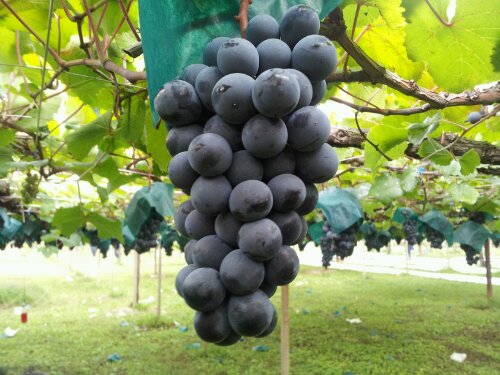American Grape Varieties in Japanese Wine
Among the grape varieties cultivated for winemaking in Japan, many are American varieties. Of these, "Niagara," "Delaware," and "Campbell Early" are particularly popular, as they have adapted well to Japan's climate and are familiar to the Japanese palate. These varieties are enjoyed as table grapes and are also valued for their unique characteristics in winemaking. Below is a detailed overview of these three varieties, including their characteristics, history, and winemaking styles.
1.Niagara: A Fragrant Variety with Excellent Cold Tolerance

Image 4-1
(Permission: https://oishii.iijan.or.jp/area/oishii/topics/present/post-2827.php)
Niagara is an American white grape variety known for its cold tolerance, making it well-suited for cultivation in colder regions like Hokkaido and Nagano Prefecture. It ranks second in domestic production among white wine grapes in Japan, following Koshu, and is the most widely grown white grape in Hokkaido. Originally developed in 1872 by crossing "Concord" and "Cassady" in New York, USA, Niagara was first introduced to Japan by Zenbei Kawakami, known as the "Father of Japanese Wine Grapes."
The signature feature of Niagara is its vibrant, sweet aroma. This grape is also popular as a table grape and is widely used in juice and jam. Its aroma, often described as "foxy" and reminiscent of grape juice, is not commonly favored for winemaking in Europe. However, in Japan, this familiar fragrance is well-received, and Niagara has earned a devoted following as an aromatic wine enjoyed for its distinctive scent.
2.Winemaking Styles for Niagara
Niagara’s unique aroma allows for a variety of wine styles.
- White Wine
Niagara white wine is known for its refreshing and fruity flavor. Its sweet aroma stands out, and a gentle sweetness unfolds on the palate, complemented by a clean acidity. This light wine style is widely enjoyed. - Sparkling Wine
Niagara’s aroma also shines in sparkling wine, where the bubbles enhance its lively scent, creating a festive and refreshing drink suitable as an aperitif. - Orange Wine
By fermenting Niagara with its skins and seeds, an orange wine is created, displaying a distinctive amber color and rich depth. This style adds tannins and body, making it a fuller wine that pairs well with rich or spicy dishes, ideal for main courses.
3.Delaware: From a Showa-Era Table Grape to a Wine Staple

Discovered as a chance seedling in the U.S. in the 1850s, Delaware was introduced to Japan in the early Meiji era. Small, easy-to-eat, and aromatic, Delaware was once a staple on Japanese tables as a seedless table grape, emblematic of the Showa era. Although its cultivation has declined, it remains widely grown in key regions like Yamagata and Yamanashi Prefectures.
Recently, Delaware has been re-evaluated for winemaking, drawing attention for its potential. Delaware wines are fresh and fruity, suited to various styles, and its adaptability to Japan’s climate, along with high acidity from certain harvesting methods, makes it a good choice for winemaking.
4.Winemaking Styles for Delaware
Image 4-2
(Permission: Same as 2-2)
Delaware is crafted in various styles, from table wines to sparkling and orange wines.
- White Wine
Delaware’s white wine is juicy and fresh, with a light acidity and fruity aroma, making it an easy-to-drink wine that pairs well with Japanese cuisine and light appetizers. - Sparkling Wine
Delaware’s sparkling wine emphasizes its rich fruit aroma, with bubbles that add a touch of elegance. Bottle-fermented sparkling wines are particularly appreciated, some even rivaling prestigious French labels. - Orange Wine
Delaware’s orange wine, made by fermenting the grape with its skins and seeds, offers a rich amber color, sweet aroma, and pleasant bitterness. This style pairs well with various cuisines, harmonizing beautifully with Japanese food culture. - Blended Wine
Delaware’s appeal also shines in blends, where its acidity and sweetness can be adjusted to create unique flavors. Wineries use creative techniques to produce distinctive Delaware blends.
5.Campbell Early: Sweet Aroma and Vibrant Color

Image 4-3
(Permission: https://www.marugotoaomori.jp/blog/2006/09/1167.html)
Campbell Early, an American-bred grape, was introduced to Japan in 1897 by Zenbei Kawakami. Known for its sweet aroma and bright red color, it has traditionally been used for table consumption and juice. Although its potential for wine was not recognized initially, recent years have seen it increasingly used for red and rosé wines.
Campbell Early is relatively resistant to disease and cold, and is widely cultivated across Japan, especially in Hokkaido and Miyazaki Prefectures. Its early ripening period, typically around mid-August, makes it valuable for ensuring a continuous grape supply.
6.Winemaking Styles for Campbell Early
Campbell Early, with its sweet aroma and light tannins, is suitable for various wine styles.
- Red Wine
Campbell Early’s red wine is fruity and light, with low tannins, making it approachable for beginners. Its vibrant aroma and compatibility with Japanese cuisine make it a popular choice. - Rosé Wine
Campbell Early rosé boasts a beautiful pink hue and sweet fragrance. With a light and fruity profile, it’s perfect for summer, enjoyed on its own or with meals. - Sparkling Wine
As a sparkling wine, Campbell Early’s fruity aroma is enhanced by bubbles, making it ideal as an aperitif or for celebrations. - Sweet Wine
Sweet wines that highlight Campbell Early’s fruity aroma are also produced, providing a dessert wine option that pairs well with sweets and light snacks.
Niagara, Delaware, and Campbell Early are American grape varieties that play a significant role in Japanese wine culture. Each variety’s unique aroma and flavor, coupled with diverse winemaking styles, harmonize with Japan’s climate and culinary traditions. These grapes, with their familiar aromatic qualities, are popular for pairing with Japanese and casual meals. Japanese wineries continue to explore new expressions of these varieties, promising even more diversity as Japanese wine evolves.



